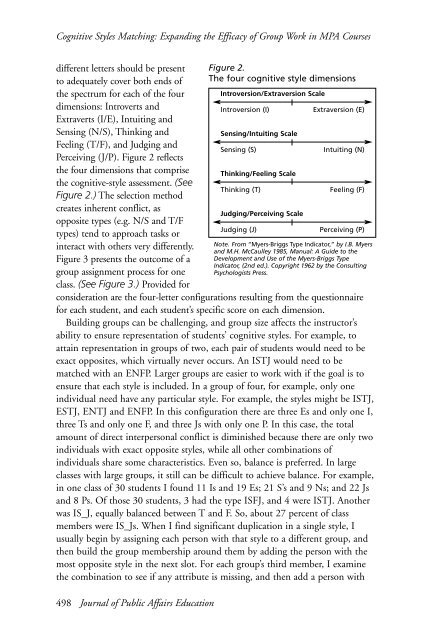JOURNAL OF PUBLIC AFFAIRS EDUCATION - National ...
JOURNAL OF PUBLIC AFFAIRS EDUCATION - National ...
JOURNAL OF PUBLIC AFFAIRS EDUCATION - National ...
Create successful ePaper yourself
Turn your PDF publications into a flip-book with our unique Google optimized e-Paper software.
Cognitive Styles Matching: Expanding the Efficacy of Group Work in MPA Courses<br />
different letters should be present<br />
to adequately cover both ends of<br />
the spectrum for each of the four<br />
dimensions: Introverts and<br />
Extraverts (I/E), Intuiting and<br />
Sensing (N/S), Thinking and<br />
Feeling (T/F), and Judging and<br />
Perceiving (J/P). Figure 2 reflects<br />
the four dimensions that comprise<br />
the cognitive-style assessment. (See<br />
Figure 2.) The selection method<br />
creates inherent conflict, as<br />
opposite types (e.g. N/S and T/F<br />
types) tend to approach tasks or<br />
interact with others very differently.<br />
Figure 3 presents the outcome of a<br />
group assignment process for one<br />
class. (See Figure 3.) Provided for<br />
consideration are the four-letter configurations resulting from the questionnaire<br />
for each student, and each student’s specific score on each dimension.<br />
Building groups can be challenging, and group size affects the instructor’s<br />
ability to ensure representation of students’ cognitive styles. For example, to<br />
attain representation in groups of two, each pair of students would need to be<br />
exact opposites, which virtually never occurs. An ISTJ would need to be<br />
matched with an ENFP. Larger groups are easier to work with if the goal is to<br />
ensure that each style is included. In a group of four, for example, only one<br />
individual need have any particular style. For example, the styles might be ISTJ,<br />
ESTJ, ENTJ and ENFP. In this configuration there are three Es and only one I,<br />
three Ts and only one F, and three Js with only one P. In this case, the total<br />
amount of direct interpersonal conflict is diminished because there are only two<br />
individuals with exact opposite styles, while all other combinations of<br />
individuals share some characteristics. Even so, balance is preferred. In large<br />
classes with large groups, it still can be difficult to achieve balance. For example,<br />
in one class of 30 students I found 11 Is and 19 Es; 21 S’s and 9 Ns; and 22 Js<br />
and 8 Ps. Of those 30 students, 3 had the type ISFJ, and 4 were ISTJ. Another<br />
was IS_J, equally balanced between T and F. So, about 27 percent of class<br />
members were IS_Js. When I find significant duplication in a single style, I<br />
usually begin by assigning each person with that style to a different group, and<br />
then build the group membership around them by adding the person with the<br />
most opposite style in the next slot. For each group’s third member, I examine<br />
the combination to see if any attribute is missing, and then add a person with<br />
498 Journal of Public Affairs Education<br />
Figure 2.<br />
The four cognitive style dimensions<br />
Introversion/Extraversion Scale<br />
Introversion (I) Extraversion (E)<br />
Sensing/Intuiting Scale<br />
Sensing (S) Intuiting (N)<br />
Thinking/Feeling Scale<br />
Thinking (T) Feeling (F)<br />
Judging/Perceiving Scale<br />
Judging (J) Perceiving (P)<br />
Note. From “Myers-Briggs Type Indicator,” by I.B. Myers<br />
and M.H. McCaulley 1985, Manual: A Guide to the<br />
Development and Use of the Myers-Briggs Type<br />
Indicator, (2nd ed.). Copyright 1962 by the Consulting<br />
Psychologists Press.

















